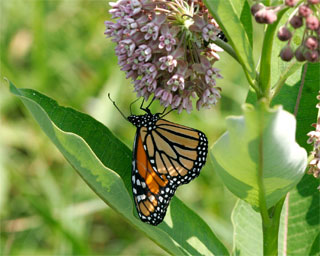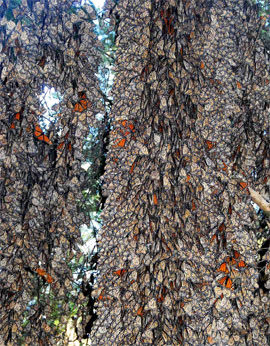Every fall, millions of monarch butterflies travel south to Mexico and take refuge in twelve mountain sanctuaries of oyamel fir forests. Now, declining numbers of the overwintering butterflies expose the migration’s vulnerability and raise questions about threats throughout the monarch’s lifecycle.
A study published online last spring in Insect Conservation and Diversity shows a decrease in Mexico’s overwintering monarch butterflies between 1994 and 2011. The butterflies face loss of wintering habitat in Mexico and breeding habitat in the United States. Extreme weather, like winter storms in Mexico and the ongoing drought in Texas, adds yet another challenge.
The seeds of the decline date back more than 40 years as commercial and subsistence logging—now illegal in the Monarch Butterfly Biosphere Reserve—have fragmented the forest on which the butterflies depend for winter survival. Between 1971 and 1999, logging degraded 44 percent of the high-quality overwintering habitat within the reserve.
 A monarch butterfly sips nectar from a common milkweed (Asclepias syriaca) in Virginia. Milkweeds supply adult monarchs with nectar, and female monarchs lay their eggs only on milkweeds. The leaves feed developing caterpillars through the summer. Photo by: Lincoln Brower. |
Thanks to its shelter and humidity, “the forest serves as an umbrella, a blanket and a hot water bottle for the butterfly,” said biologist Lincoln Brower of Sweet Briar College in an interview with mongabay.com. Brower, who has studied monarchs for 56 years, compares removing even a single tree to cutting a hole in the blanket.
Loss of breeding habitat also is a concern. The common milkweed, a flower of eastern and midwestern U.S. fields and gardens, is the main host for monarch eggs and larvae. Growing numbers of large-scale farms use genetically modified and pesticide-resistant crops, so milkweed interlopers have nearly disappeared from the fields of corn and soybean that carpet the midwestern U.S. “There’s not a weed in sight as far as an eye can see,” said Brower.
Monarchs are prolific; each female lays 400 to 1,000 eggs. But Brower worries that a poor breeding season, combined with a tough migration and severe winter weather in Mexico, could devastate the population.
This fall, monarchs are navigating a drought-stricken landscape as the migration funnels through Texas. According to Brower, it will be “stress, stress, stress” as the butterflies search for nectar sources in the parched region.
 Overwintering monarch butterflies cluster on an oyamel fir trunk in Mexico. Photo by: Ernest H. Williams. |
Ecologist Andrew Davis of the University of Georgia, who was not involved with the study, agrees there are threats to monarch wintering and breeding habitats. But he doesn’t think that winter declines tells the whole story. “If you wanted to know if the monarchs are declining in the east, you have to look at multiple datasets,” Davis said in an interview with mongabay.com.
For example, Davis published a study last summer in Insect Conservation and Diversity that found no decline in New Jersey and Michigan monarchs during the fall seasons between the 1990s and 2010.
Monarch conservationist Bill Toone, director of the ECOLIFE Foundation of San Diego, California, welcomes the debate—and the data—from both studies. “On one hand, it’s great to get a sense that in some parts of North America it looks like monarch butterflies are doing OK. On the other hand, I don’t think it’s reflective of the whole North American phenomenon,” Toone told mongabay.com.
Toone warns that monarch aficionados should not rest easy: “I know from my 23 years of experience going to Mexico, you don’t have to be a scientist to be able to tell that the number of butterflies has just been in a horrific decline in those overwintering areas.”
CITATIONS: Brower LP, Taylor, OR, Williams EH, Slayback DA, et al. Decline of monarch butterflies overwintering in Mexico: is the migratory phenomenon at risk? Insect Conservation and Diversity, 21 March 2011. DOI: 10.1111/j.1752-4598.2011.00142.x
Davis AK. Are migratory monarchs really declining in eastern North America? Examining evidence from two fall census programs. Insect Conservation and Diversity, 20 June 2011. DOI: 10.1111/j.1752-4598.2011.00158.x
Sarah Jane Keller is a graduate student in the Science Communication Program at the University of California, Santa Cruz.
Related articles